Interesting Facts About Bobcats You Never Knew
Bobcats are fascinating creatures with unique adaptations you might not know about. They possess exceptional night vision and can leap up to 12 feet, thanks to powerful hind legs. Their diet is diverse, ranging from small mammals to larger prey like deer. You'll find bobcats in various habitats, from dense forests to suburban areas, with males claiming territories up to 30 square miles. These solitary animals have a short gestation period, giving birth to litters of two to four kittens. While classified as least concern globally, bobcats face regional conservation challenges. Their adaptability has led to increased urban sightings, showcasing their resilience. Exploring further reveals even more intriguing aspects of these remarkable felines.
This post may contain affiliate links. If you make a purchase through these links, I may earn a commission at no additional cost to you. Additionally, portions of this post may be generated using artificial intelligence (AI) technology. While we strive for accuracy, please be aware that AI-generated content may not always be perfect and should be fact-checked when necessary.
The Spatula Scoops
- Bobcats can leap up to 12 feet, thanks to their powerful hind legs and sharp retractable claws.
- Their coat color varies by environment, with lighter shades in arid regions and darker hues in forests.
- Bobcats have a unique fifth toe on their paws, aiding in track differentiation from other wild cats.
- They can run at speeds of 25-30 mph and possess exceptional night vision for efficient hunting.
- Bobcats cache their prey, burying excess food for later consumption to adapt to fluctuating food availability.
Physical Characteristics and Adaptations
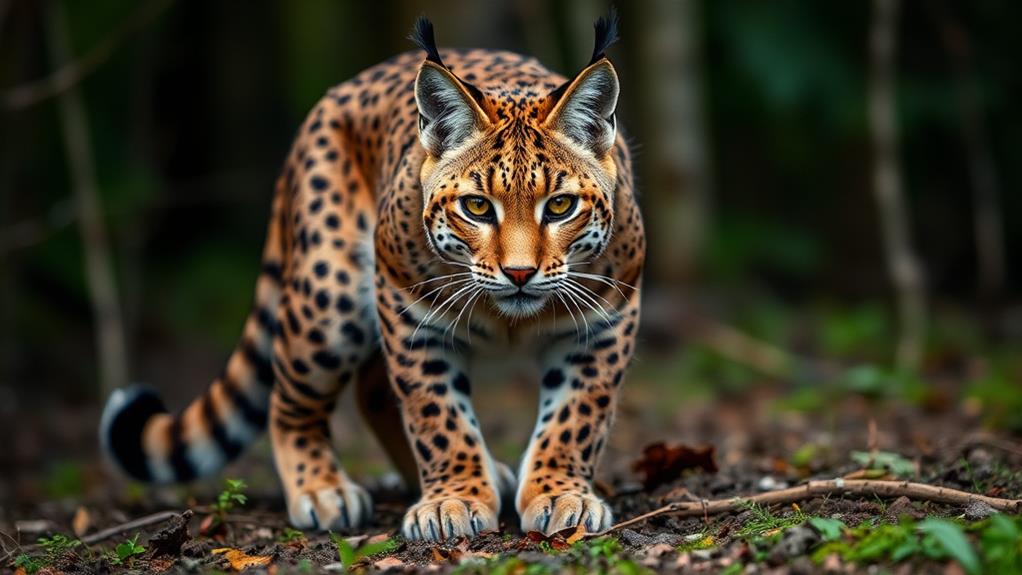
With their distinctive short tails and spotted coats, bobcats are nature's masters of camouflage. You'll find that these felines have adapted their appearance to blend seamlessly with their surroundings. Their coat color varies depending on habitat, sporting lighter shades in arid regions and darker hues in forested areas. This adaptability guarantees they remain hidden from both prey and potential threats.
When you look closely at a bobcat's physical characteristics, you'll notice their large paws with a unique fifth toe. This raised toe helps differentiate their tracks from domestic cats, showing a direct register pattern. Their sharp, retractable claws and powerful hind legs are built for action, allowing them to leap an impressive 12 feet to catch prey.
You might wonder how bobcats navigate in the dark. Their exceptional night vision, combined with the ability to run at speeds of 25 to 30 miles per hour, makes them formidable nocturnal hunters. These adaptations enable bobcats to thrive in various terrains, from dense forests to open grasslands. Their physical features and keen senses work together, making them highly effective predators in their ecosystems.
Hunting Techniques and Diet

You'll find bobcats to be masterful ambush predators, employing stealth and patience to catch their prey off guard. Their diverse diet includes small mammals like rabbits and rodents, but they're not afraid to tackle larger game such as deer when necessary. Bobcats' adaptable feeding habits allow them to adjust their menu based on what's available, even caching excess food for later consumption.
Ambush Predator Tactics
Masters of stealth, bobcats employ a range of cunning tactics to hunt their prey. You'll find these feline predators most active during twilight hours, taking advantage of low-light conditions to ambush unsuspecting victims. Their crepuscular behavior enhances their hunting success, as they blend seamlessly into the shadows.
When stalking prey, bobcats exhibit remarkable patience and agility. They'll quietly approach their target, often utilizing cover from vegetation or terrain features. Once within striking distance, they'll release an impressive leap of up to 12 feet, swiftly capturing their quarry. This ambush technique relies heavily on their natural camouflage and silent movement.
You might be surprised to learn that bobcats can sprint at speeds of 25 to 30 miles per hour in short bursts. This ability not only aids in chasing down prey but also allows for quick escapes if needed. Their diet primarily consists of small mammals, but they're opportunistic feeders, occasionally tackling larger prey when necessary. Curiously, bobcats have been observed caching excess food by burying it, a behavior that allows them to return and consume it later, much like their larger cousin, the mountain lion.
Diverse Prey Selection
Adaptability defines the bobcat's approach to hunting and diet. These remarkable felines showcase a diverse prey selection that allows them to thrive in various environments. You'll find that bobcats primarily target small mammals, especially rodents and rabbits, but they're not limited to these options.
As opportunistic hunters, bobcats adjust their menu based on what's available. They'll pursue birds, reptiles, and even fish when the opportunity arises. In times of scarcity, they're capable of taking down larger prey like deer. This flexibility guarantees their survival in changing ecosystems.
Bobcats employ stealthy ambush techniques to catch their prey. They're crepuscular hunters, meaning they're most active during dawn and dusk. This timing takes advantage of low light conditions, enhancing their hunting success. With impressive agility, they can leap up to 12 feet in a single bound to pounce on unsuspecting targets.
Interestingly, bobcats demonstrate resourcefulness by caching uneaten prey. They'll bury excess food for later consumption, a clever strategy that helps them cope with fluctuating food availability. This behavior showcases their ability to plan ahead and adapt to their environment's challenges.
Adaptable Feeding Habits
Through their adaptable feeding habits, bobcats demonstrate remarkable versatility as predators. You'll find these resourceful hunters adjusting their diet based on prey availability in their environment. As opportunistic feeders, bobcats primarily target small mammals like rabbits and rodents, but they're not limited to these options. When food becomes scarce, they'll even take on larger prey such as deer.
Bobcats excel at ambush hunting, utilizing their excellent night vision to stalk and surprise their targets. They're known to pounce from impressive distances, leaping up to 12 feet to capture their prey. You might be surprised to learn that bobcats are crepuscular hunters, preferring to hunt during dawn and dusk for ideal success.
Their flexible diet allows them to thrive in various habitats. When they've caught more than they can eat, bobcats don't let it go to waste. They'll often bury their excess prey, creating a cache for later consumption. This behavior showcases their adaptability and guarantees they have food even when hunting conditions are less favorable. By caching buried prey, bobcats demonstrate their resourcefulness in managing their food supply.
Habitat and Territory
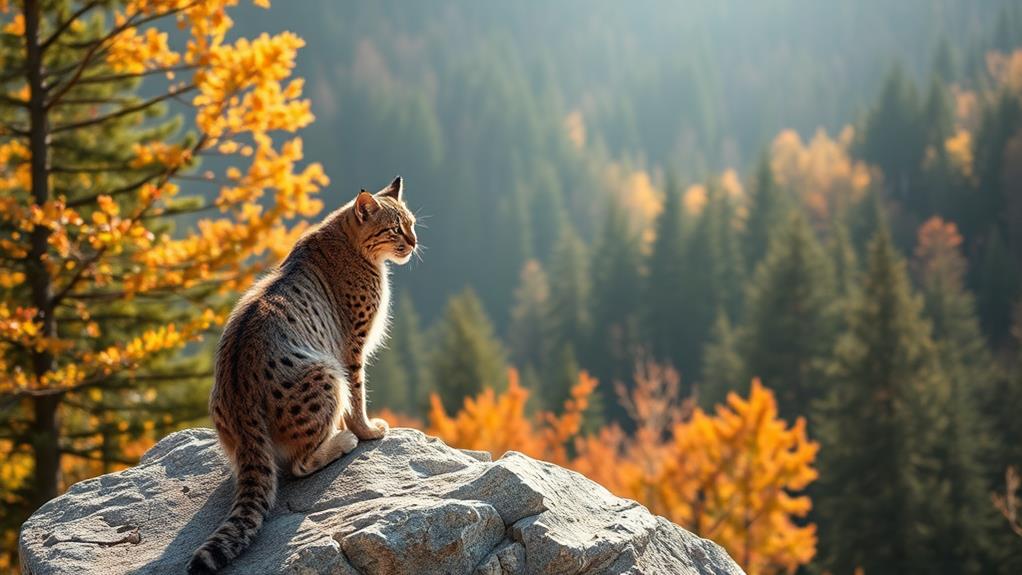
Bobcats thrive in a wide range of habitats across North America, from dense forests to arid deserts and even suburban areas. Their adaptability is remarkable, allowing them to establish territories in diverse environments. You'll find these solitary creatures carving out their own spaces, with males claiming up to 30 square miles and females settling for smaller areas of 5 to 6 square miles.
These felines are territorial masters, using various methods to mark their boundaries. They'll leave scent markings, scratch trees with their claws, and vocalize to warn off intruders. It's their way of saying, "This is my turf, stay out!" Within their territories, bobcats set up multiple dens for safety and shelter. These can be caves, hollow logs, or rock shelters, providing secure spots for resting and raising their young.
You might think bobcats would constantly clash over territory, but they're actually quite avoidant. Males and females typically keep to themselves, only interacting during mating season. This solitary lifestyle helps minimize territorial disputes and maintains the balance in their chosen habitats.
Reproduction and Lifecycle
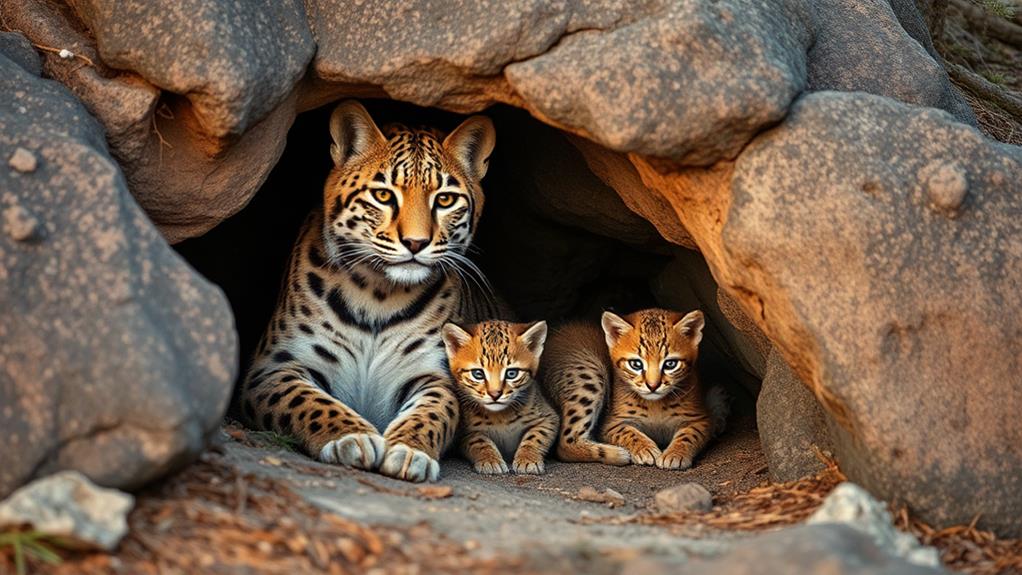
You'll find bobcats' reproductive cycle fascinating, as it follows a distinct seasonal pattern. Their mating season occurs in late winter, typically February and March, with kittens born about two months later. After birth, you'll see that bobcat mothers are solely responsible for raising their litters, which usually consist of three kittens, in secluded dens until the young become independent at around 5-6 months old.
Mating Season and Gestation
When it comes to bobcat reproduction, you'll find their mating season occurs in February and March. During this time, these felines prepare for the next generation, engaging in courtship behaviors and mating rituals. After successful mating, female bobcats enter a gestation period that lasts approximately two months. This relatively short pregnancy guarantees that kittens are born when food is more abundant.
Once the gestation period concludes, female bobcats give birth to their litters. Typically, you'll see litter sizes averaging around three kittens, though it's not uncommon for litters to range from two to four. These newborn kittens are born blind and completely dependent on their mother for care and nourishment. For about two months, the kittens remain in the safety of their den, gradually developing and gaining strength.
As the young bobcats grow, they begin to venture out of the den, exploring their surroundings under their mother's watchful eye. You'll notice that these kittens usually gain independence between five to six months of age. However, they may continue to stay within their mother's territory for additional support and protection as they hone their survival skills.
Litter Size and Care
After giving birth, female bobcats face the significant task of nurturing their litters. You'll find that a typical litter size for these felines ranges from two to four kittens, with an average of three. These newborns enter the world blind and helpless, relying completely on their mother's care for survival.
For the first two months, maternal care is essential as the kittens develop and grow. Around the one-month mark, you'll see mothers introducing prey to their offspring, initiating the process of teaching crucial hunting skills. This education continues until the kittens reach independence at about five to six months old.
The maternal care provided by female bobcats is extensive and includes not only feeding but also protecting and training their young. You'll notice that as the kittens grow, they become more active and curious, mirroring their mother's behavior and honing their hunting techniques.
At around 11 months, you'll observe young bobcats being expelled from their mother's territory. This marks the beginning of their journey to establish their own ranges and survive independently, completing the cycle of bobcat reproduction and development.
Kitten Development Timeline
The journey from helpless newborn to independent bobcat follows a fascinating timeline. When born, bobcat kittens are blind and entirely dependent on their mother. With an average litter size of three, these tiny felines rely on their mother for nourishment and protection during their first weeks of life.
Around two weeks old, you'll notice a significant change in the kittens' development. Their eyes begin to open, and they start gaining mobility. This newfound ability allows them to explore their den under their mother's watchful eye. As they grow, their curiosity and strength increase, preparing them for the next stages of life.
By four to five months, young bobcats commence an exciting phase of their development. They begin accompanying their mother on hunting trips, learning vital survival skills. This period is essential for their future independence, as they observe and practice hunting techniques.
The final stage of a bobcat's kitten development timeline occurs around 11 months of age. At this point, most young bobcats leave their mother's territory and establish their own home range. However, maternal care can extend up to a year in some cases, ensuring the kittens are fully prepared for life on their own.
Bobcat-Human Interactions
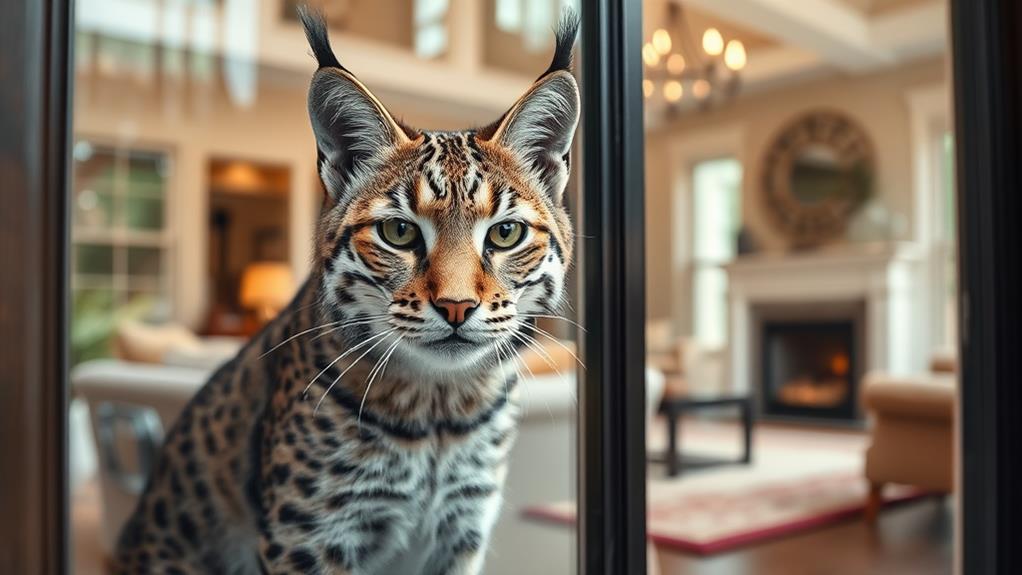
Bobcats' relationship with humans has evolved considerably over time. You might be surprised to learn that these elusive felines are increasingly adapting to urban areas, with sightings becoming more common in places like suburban Dallas-Fort Worth. This adaptability showcases the bobcat population's resilience in the face of human expansion.
While ancient civilizations may have attempted domestication efforts for pest control, bobcats' solitary nature makes them challenging to tame. Even Calvin Coolidge, the 30th U.S. President, had a bobcat named Smoky, which he eventually transferred to a zoo. Today, you're more likely to encounter bobcats in regulated hunting practices, permitted in 38 U.S. states and parts of Canada.
Despite their ability to thrive near human settlements, bobcats generally avoid high-traffic areas. This behavior highlights their remarkable adaptability to changing environments while maintaining a safe distance from humans. As you explore urban or suburban areas, keep in mind that these wild cats may be closer than you think, quietly coexisting with human developments while preserving their natural instincts and behaviors.
Are There Any Similarities Between Bobcats and Bears That Make Them Fascinating?
Bobcats and bears are both skilled survivors in the wild, captivating nature enthusiasts with their unique behaviors. While bobcats are stealthy hunters, bears impress with their strength and adaptability. Learning about their shared traits, like their solitary lifestyles, makes exploring interesting facts about bears even more engaging for wildlife lovers.
Conservation Status and Challenges
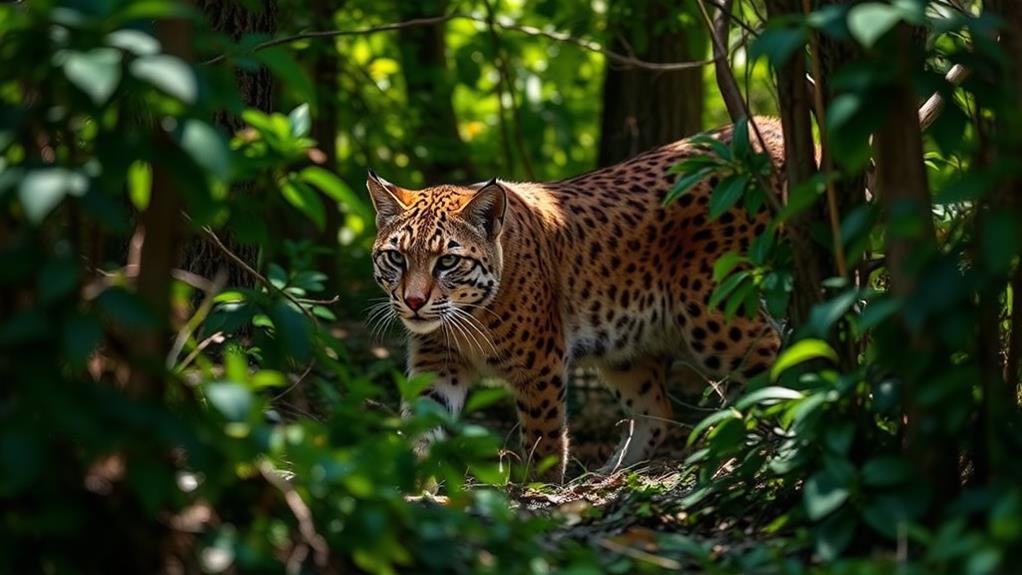
Despite their widespread presence, bobcats face varying conservation challenges across their range. While the International Union for Conservation of Nature (IUCN) classifies bobcats as a species of least concern, indicating stable populations overall, certain regions tell a different story. In Ohio, Indiana, and New Jersey, bobcats are considered endangered species, highlighting the need for targeted conservation efforts.
Conservation status varies due to several factors:
- Habitat loss from urban sprawl
- Fragmentation of forested areas
- Human-wildlife conflicts
- Hunting pressures in some regions
Habitat protection plays a vital role in maintaining bobcat populations. Conservation initiatives focus on preserving natural areas and creating wildlife corridors to connect fragmented habitats. These efforts help bobcats maintain their range and genetic diversity.
While hunting is permitted in many areas, sustainable practices and regulations contribute to overall population stability. However, the Mexican bobcat subspecies faces unique challenges and is classified as endangered by the U.S. Fish and Wildlife Service.
You'll find that bobcat conservation involves a delicate balance between human activities and wildlife needs. By understanding these challenges, you can appreciate the importance of ongoing conservation efforts to guarantee bobcats continue to thrive in their natural habitats.
Frequently Asked Questions
What Are 5 Interesting Facts About Bobcats?
You might think bobcats are just oversized house cats, but you'd be wrong! Here are five fascinating facts: 1) Their short tail is only 6-7 inches long. 2) They're versatile hunters, tackling prey from mice to deer. 3) Males roam territories up to 30 square miles. 4) They're incredible athletes, leaping 12 feet and sprinting at 30 mph. 5) Their vocalizations can carry over a mile. These agile predators are more remarkable than you'd imagine, combining strength, speed, and adaptability in a compact package.
What Are Bobcats Most Known For?
Bobcats are most known for their distinctive short tail, which typically measures 4 to 7 inches. You'll recognize this feature as it's what gives them their name. They're also renowned for their impressive hunting skills, using ambush techniques and leaping up to 12 feet to catch prey. You'll find bobcats are highly adaptable, thriving in diverse habitats from forests to suburbs. Their solitary nature and territorial behavior, with males covering up to 30 square miles, are other notable characteristics.
What Are Bobcat Babies Called?
You'll find that bobcat babies are called "kittens," just like their domestic cat cousins. They're born in litters of typically 2 to 4, though you might see anywhere from 1 to 6 kittens. When they're first born, they're blind and completely dependent on their mother. As they grow, you'll notice them becoming more independent, starting to hunt on their own around 5 to 6 months old. The mother plays a vital role in teaching them essential survival skills.
Why Are Bobcats Unique?
You'll find bobcats unique for several reasons. They're the smallest of the lynx species, with distinctive bobbed tails and spotted fur. Their adaptability is remarkable; they thrive in various habitats, including urban areas. You'll be impressed by their hunting prowess, using ambush tactics and leaping up to 12 feet to catch prey. Their excellent night vision and strong hind legs give them an edge. Bobcats are solitary and territorial, with males covering larger territories than females.





